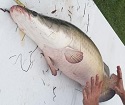 University of Florida Institute of Food and Agricultural Sciences researchers are studying whether Arapaima fish could be a viable food fish in the United States. South Americans eat the fish regularly; it is normally found in freshwater rivers and actually has been overfished in many areas.
University of Florida Institute of Food and Agricultural Sciences researchers are studying whether Arapaima fish could be a viable food fish in the United States. South Americans eat the fish regularly; it is normally found in freshwater rivers and actually has been overfished in many areas.
The University of Florida researchers are in favor of introducing the non-native fish to U.S. fish farming operations in South Florida, and that is about the only place they could be grown in the U.S. because the water has to be about 61 degrees Fahrenheit or warmer.
The university researchers also confirmed that the fish would prey on other fish if they got into the wild, but those researchers apparently are confident there is a very low risk of the Arapaima getting out of fish farms.
There seems to be a bit of overconfidence about keeping a non-native fish species in captivity when hurricanes and floods can hit the open-air fish farming operations. A lot of people look at the spread of Asian carp into waters where they were never expected to habitat. It actually seems too bad that Arapaima couldn’t survive in the same waters as Asian carp and eat those nasty fish, which aren’t good food fish.
As for the Arapaima, Jeffrey Hill, a UF/IFAS associate professor of fisheries and aquatic sciences, said, “It has lots of high-quality meat. It’s an easy fish to sell. It’s a really good food fish. It’s one of my favorites. It’s has a good taste. It’s easy to cook.”
Hill, doctoral student Katelyn Lawson and other researchers at the UF/IFAS Tropical Aquaculture Laboratory in Ruskin, Fla., recently published their two studies concerning Arapaima. The risk analysis was published in the North American Journal of Fisheries Management, while the lethal temperature study was published in the North American Journal of Aquaculture.
“Arapaima is popular as a food fishery species in South America, where it is native,” said Hill. “Other markets for the meat include the U.S., Europe and Japan. There’s lots of interest in raising them in Southeast Asia, Brazil and at least one farm so far in Florida.” Continue reading – http://www.agprofessional.com/news/non-native-fish-introduction-us
